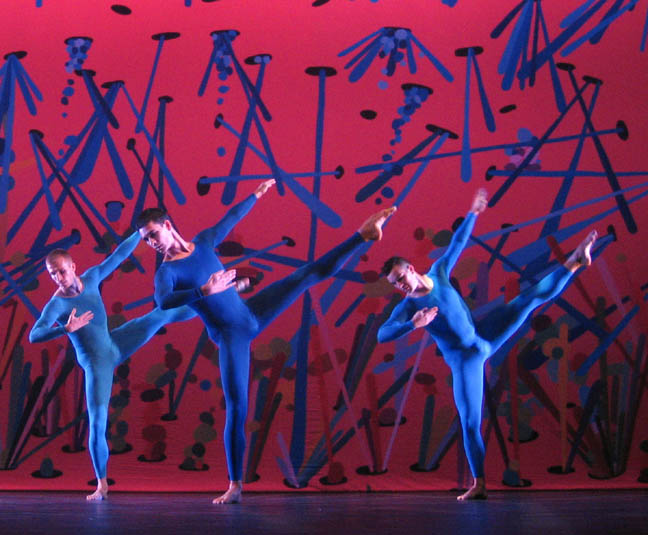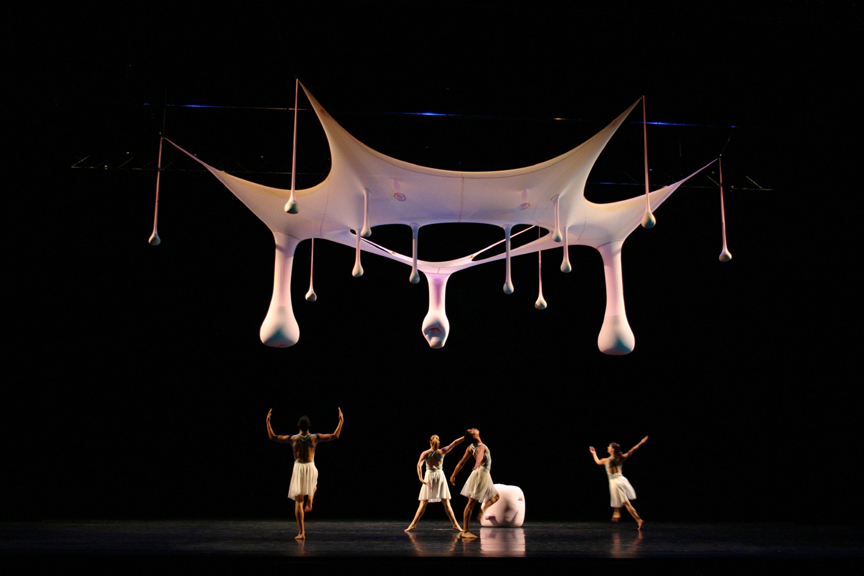“Democracy in Action”: Merce Cunningham in Minnesota
Camille LeFevre caught Merce Cunningham's company at the College of St Benedict in St Joseph, a small town near St Cloud. Their radicalism remains intact.


It’s perhaps one of the Dada movement’s most famous anecdotes. In 1920, artist Hans Arp, frustrated with a drawing he’d been working on, tore it to bits and let the pieces drop to the floor. Later, struck by the pattern the scraps had created, he pasted them down and called the artwork “According to the Laws of Chance.” “Chance movements of his hand and of the fluttering scraps of paper had achieved what all his efforts had failed to achieve, namely expression,” wrote Hans Richter in Dada: Art and Anti-Art. “The conclusion that Dada drew from all this was that chance must be recognized as a new stimulus to artistic creation.” That stimulus has never let up and lives on today in the work of Merce Cunningham, still America’’s most profoundly innovator choreographer at age 88.
In the 1950s, largely inspired by the chance-infused, found-object “ready-mades” and calculated aesthetic experiments of their friend Dada artist Marcel Duchamp, musician John Cage and choreographer Merce Cunningham decided to break with traditional methods of composition in their own artistic disciplines and rely, instead, on the fortuitously expressive power of chance. Since then, every Cunningham dance work been choreographed through such chance methods as dice-tossing, coin-throwing and the computer program DanceForms. All elements of a Cunningham production— choreography, score, costumes, décor, lighting— have also been created independently, coming together for the first time on opening night. And the “chance operations,” as Cunningham calls them, don’’t always stop there.
Which brings us to last Thursday night’’s performance of Cunningham’s newest work, “eyeSpace,” at the College of Saint Benedict in Saint Joseph. Before entering the auditorium, each audience member was outfitted with an iPod ready to play 10 shuffled tracks of Mikel Rouse’s score, “International Cloud Atlas.” Each shuffle on each iPod was different. After we sat down, sound supervisor Stephan Moore, who commandeered an environmental soundscape from the orchestra pit, told us to play our iPods “now.” And so the adventure began.
The audience collectively gasped as the curtains parted to reveal Henry Samelson’s vibrant mural of blue, red, yellow and green round and linear shapes, saturated with color by Josh Johnson’s lighting. Wearing unitards in various shades of purple or blue, the dancers darted— in quartets, duets and trios— through fast-paced series of angular poses, often while on demi-point, or balancing on one leg while precariously pitching backward, or while tilting through a spin while in releve. At the same time, beautiful songs, quiet voices and ambient sounds were playing on my iPod; a soothing mix that made me look at the dancing as lovely, lyrical, harmonious. Meanwhile, the soundscape playing in the auditorium was a compelling mix of traffic and sirens, children shouting, and birds chirping. I frequently turned down the volume in my iPod to hear it. The multi-media, surround-sound experience was thrilling.
An anecdote related by Alastair Macaulay in his article “Democracy in Action, That’’s when Cunningham” (New York Times, April 19) suddenly came to mind. And the essence of Cunningham’s chance methodology in “eyeSpace” became crystal clear. Back in 1954, after choreographing “Minutiae,” one of Cunningham’’s dancers asked him what the piece meant. He took her to the window, pointed at the busy streetscape below, and said “That!” A version of which was still happening a half-century later at a small Catholic college in rural Minnesota.
While we were all listening to our own shuffles, and making associations and finding insights between music, lighting, dance and décor independently, we were enjoying the singularity of our experiences together. Equally. Democratically. We could as well have been walking down a bustling urban sidewalk, noticing the movement interactions of diverse pedestrians as they intersected with each other, hearing the sounds of traffic in between iPod songs while dodging cars in the street. But we were in a concert hall. Experiencing the everyday transformed into art. And those moments would never happen again.
Case in point. On Saturday night, the Merce Cunningham Dance Company performed “eyeSpace” again (replacing “Sounddance,” which was dropped from the program due to a dance injury). As MCDC executive director Trevor Carlson explained to a group of us beforehand, the performance would mark the first time Samelson’’s décor and Annea Lockwood’’s score (for one person on laptop and two people on variable instruments) would occur together. In addition, while one of the musicians had previously performed the score, the two others had not. (“eyeSpace” also has a second décor, an Art Deco-style façade by Daniel Arsham; and another possible score, by David Behrman.)
Lockwood’’s score includes insect sounds recorded underwater, gongs and piano, but also requires the live musicians to respond to photographs of rocks in water marked by water lines. No iPods. This time, rather than reading the choreography as lyrical, the earthy but electronic score caused me to view the movement as sharp, linear and increasingly mechanical. Something a friend once said to me years ago after a Cunningham performance at Northrop came to mind: “A little Merce goes a long way.” There were certainly moments during “eyeSpace,” “Fabrications” (1987) and “Views on Stage” (2004), also on Saturday night’s program, when I felt this way. The coolness, sophistication, detachment, efficiency, virtuosity—the relentlessly rigorous qualities of Cunningham’s choreography and their flawless execution—are inescapable.
But Thursday’’s “eyeSpace” had a liberating influence. During “Views on Stage,” the contrasts between Ernesto Neto’s pendulous, soft, suspended sculpture and the arrested motion of the choreography’s abrupt, piece-by-piece movements were stunning. Poses rendered flat like ancient friezes coordinated with Cage’s score of crashing piano chords or appeared during silence. The detail in every hand movement, head tilt, or arm held upright was astounding. During “Fabrications,” long skeins of leaps, jumps, spins, turns and runs; long, slow leg extensions; rond de jambe en l’air; and fast, intricate duets overlapped in patterns that seemed to mimic the solid verticals, dotted lines and spirals in Dove Bradshaw’s décor.
In other words, viewing Cunningham was no longer only challenging or edifying. I’d come to embrace the qualities of chance that Richter, Dada artist and documentarian, described as “the techniques of free association, fragmentary trains of thought, unexpected juxtapositions of words and sounds…a new unity combining chance and design.” In other words, I’’d found a new context from which to view Cunningham, and it was culturally relevant, aesthetically exhilarating –and fun.